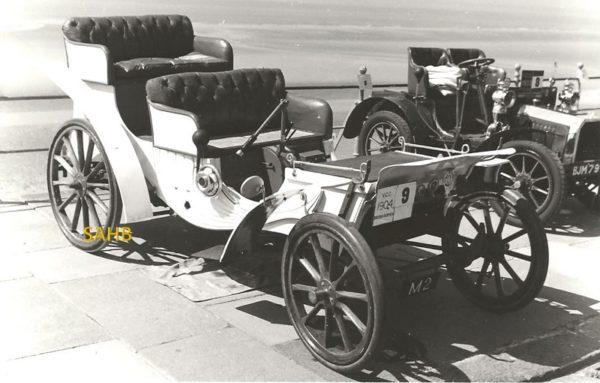
As an adjective, ‘bizarre’ seems quite inadequate to describe this vehicle, obviously photographed at a sea-side veteran car rally. Its appearance suggests an origin as its creator’s idea of an early car, uninfluenced by the actual sight of one, with only word-of-mouth descriptions of a horseless carriage from which to work. But it was no escapee from a fairground ride, but a genuine veteran car and was one of a fair number of its kind sold from Coventry but built in Rugby.
The Duryea claimed to be one of the first petrol-engined cars built in America and the Duryea brothers entered production with cars of a similar but smaller and simpler design in 1896-7. They sold reasonably well until centre-engined light cars such as the Oldsmobile and Cadillac appeared on the market; well enough to encourage Henry Sturmey, then Editor of The Autocar, to take out a licence for Duryeas to be made in England. In fact, the Rugby engineering company, Willans & Robinson undertook this, which came to an end in 1906. Back in America, Charles Duryea in particular confidently saw no merit in abandoning their design and a new company still offered very similar cars as late as 1912.
Not only was the appearance eccentric, but so also was the specification of this 1904 model – the horizontally-placed 3½-litre three cylinder engine had push-rod operated overhead valves and was mounted at floor level under the front seat, valves aft and crankshaft to the fore. Drive went via a two-speed epicyclic gearbox and single chain final drive to a live rear axle. The carriage-like wooden wheels carried solid rubber tyres and the length of the leaf springs was considered adequate to deliver a comfortable ride. Bar one pedal, all the controls were in a central console from which sprouted the steering tiller.
Unrestored, this British Duryea had been in the hands of active enthusiasts since the 1940s, they being Kenneth Neve and Major James Gardiner (see ‘Snapshot’ 240), each of whom then lived in the Warrington area. The Stothert family, father Max and his sons Tom, Dick and John, of south Lancashire took over the project and had it restored and running in time for the London to Brighton Veteran Can Run of 1956 – its debut on the rallying scene. They made it, but the journey took over 14 hours and overheating due to a cooling system leak called for many stops for water, totalling 30 gallons. Our photograph was taken as a VCC North-western Section minor event at St Annes-on-Sea the following year.
The mudguards were temporary wooden ones, and the rear seat a reproduction yet close to catalogue illustration and position, but most of this British Duryea was original. The car then disappeared, not to surface for over 45 years when in 2005, Christie’s held a sale of the Sharpe Family collection of all kinds and ages of historic motor vehicles, cycles and automobilia. Cars alone comprised more than 200 of the lots. The car’s registration number, M2, was sold separately: the car itself moved to another major collection in Surrey. One anticipates that the Duryea’s buyer has had to do a considerable amount of head-scratching to get to grips with such an unusual piece of engineering, and if this British Duryea has made a recent reappearance, then it has escaped your contributor’s notice.
This is the third of the Snapshots generously provided by the late John Warburton before his passing in January 2020. We are privileged to be able to acknowledge his contribution.







I am not sure whether any other British Duryeas survive. There is one other Duryea in the UK, but this had automatic inlet valves so was probably an import from America originally rather than a British built example. A similar six seater car but with surrey top is housed in the Summer Palace in Beijing, whist several other cars survive in America.